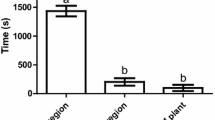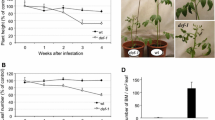Abstract
In the last decade, biological control programs for greenhouse tomatoes and other crops have been successfully implemented using zoophytophagous plant bugs (Miridae), which can feed on both plant tissues and insect prey. It is well known that plants respond to herbivore attacks by releasing volatile compounds through diverse pathways triggered by phytohormones. These herbivore-induced plant volatiles can alert neighboring plants, repel or attract herbivores, and attract natural enemies of these herbivores. Nevertheless, the possible benefits of induced plant responses by zoophytophagous predators that could add to their usefulness as biocontrol agents have not been studied until now. Here we show that the zoophytophagous predator Nesidiocoris tenuis activated abscisic acid and jasmonic acid (JA) signaling pathways in tomato plants, which made them less attractive to the whitefly Bemisia tabaci, a major tomato pest worldwide, and more attractive to the whitefly parasitoid, Encarsia formosa. We also found that intact tomato plants exposed to volatiles from N. tenuis-punctured plants activated the JA pathway, and as a consequence, E. formosa was also attracted to these intact plants with activated defense systems. Thus, our results demonstrate that N. tenuis not only benefits tomato plants directly by entomophagy but also indirectly by phytophagy, which induces a physiological response in the tomato plant.






Similar content being viewed by others
References
Asselbergh B, Curvers K, Franca SC, Audenaert K, Vuylsteke M, Van Breusegem F, Hofte M (2007) Resistance to Botrytis cinerea in sitiens, an abscisic acid-deficient tomato mutant, involves timely production of hydrogen peroxide and cell wall modifications in the epidermis. Plant Physiol 144:1863–1877
Bennett RN, Wallsgrove RM (1994) Secondary metabolites in plant defense-mechanisms. New Phytol 127:617–633
Bodenhausen N, Reymond P (2007) Signaling pathways controlling induced resistance to insect herbivores in Arabidopsis. Mol Plant Microbe Interact 20:1406–1420
Bonaventure G, VanDoorn A, Baldwin IT (2011) Herbivore-associated elicitors: FAC signaling and metabolism. Trends Plant Sci 16:294–299
Bueno VHP, van Lenteren JC, Lins JC, Calixto AM, Montes FC, Silva DB, Santiago LD, Pérez LM (2013) New records of Tuta absoluta (Meyrick) (Lepidoptera:Gelechiidae) predation by Brazilian Hemipteran predatory bugs. J App Entomol 137:29–34
Calvo J, Blockmans K, Stansly PA, Urbaneja A (2009) Predation by Nesidiocoris tenuis on Bemisia tabaci and injury to tomato. Biocontrol 54:237–246
Calvo FJ, Lorente MJ, Stansly PA, Belda JE (2012a) Preplant release of Nesidiocoris tenuis and supplementary tactics for control of Tuta absoluta and Bemisa tabaci in greenhouse tomato. Entomol Exp Appl 143:111–119
Calvo FJ, Soriano J, Bolckmans K, Belda JE (2012b) A successful method for whitefly and Tuta absoluta control in tomato. Evaluation after two years of application in practice. IOBC/WPRS Bull 80:237–244
Castañé C, Arnó J, Gabarra R, Alomar O (2011) Plant damage to vegetable crops by zoophytophagous mirid predators. Biol Control 59:22–29
Chen MS (2008) Inducible direct plant defense against insect herbivores: a review. Insect Sci 15:101–114
Choh Y, Takabayashi J (2006) Herbivore-induced extrafloral nectar production in lima bean plants enhanced by previous exposure to volatiles from infested conspecifics. J Chem Ecol 32:2073–2077
Coll M (1996) Feeding and ovipositing on plants by an omnivorous insect predator. Oecologia 105:214–220
Coll M, Guershon M (2002) Omnivory in terrestrial arthropods: mixing plant and prey diets. Annu Rev Entomol 47:267–297
Davis JM, Gordon MP, Smit BA (1991) Assimilate movement dictates remote sites of wound-induced gene-expression in poplar leaves. Proc Natl Acad Sci USA 88:2393–2396
De Puysseleyr V, Hofte M, De Clercq P (2011) Ovipositing Orius laevigatus increase tomato resistance against Frankliniella occidentalis feeding by inducing the wound response. Arth-Plant Int 5:71–80
Desneux N, Wajnberg E, Wyckhuys K, Burgio G, Arpaia S, Narváez-Vasquez C, González-Cabrera J, Catalán-Ruescas D, Tabone E, Frandon J, Pizzol J, Poncet C, Cabello T, Urbaneja A (2010) Biological invasion of European tomato crops by Tuta absoluta: ecology, geographic expansion and prospects for biological control. J Pest Sci 83:197–215
Dicke M (2009) Behavioural and community ecology of plants that cry for help. Plant Cell Environ 32:654–665
Erb M, Meldau S, Howe GA (2012) Role of phytohormones in insect-specific plant reactions. Trends Plant Sci 17(5):250–259
Flors V, Ton J, van Doorn R, Jakab G, Garcia-Agustin P, Mauch-Mani B (2008) Interplay between JA, SA and ABA signalling during basal and induced resistance against Pseudomonas syringae and Alternaria brassicicola. Plant J 54:81–92
Forcat S, Bennett MH, Mansfield JW, Grant MR (2008) A rapid and robust method for simultaneously measuring changes in the phytohormones ABA, JA and SA in plants following biotic and abiotic stress. Plant Methods 4:16
Frost CJ, Mescher MC, Carlson JE, De Moraes CM (2008) Plant defense priming against herbivores: getting ready for a different battle. Plant Physiol 146:818–824
Hairston NG, Smith FE, Slobodkin LB (1960) Community structure, population control, and competition. Am Nat 94:421–425
Halitschke R, Hamilton JG, Kessler A (2011) Herbivore-specific elicitation of photosynthesis by mirid bug salivary excretions in the wild tobacco Nicotiana attenuata. New Phytol 191:528–535
Heil M (2008) Indirect defence via tritrophic interactions. New Phytol 178:41–61
Heil M, Ton J (2008) Long-distance signalling in plant defence. Trends Plant Sci 13:264–272
Kahn TL, Fender SE, Bray EA, Oconnell MA (1993) Characterization of expression of drought and abscisic acid-regulated tomato genes in the drought-resistant species Lycopersicon pennellii. Plant Physiol 103:597–605
Kessler A, Baldwin I (2004) Herbivore-induced plant vaccination. Part I. The orchestration of plant defenses in nature and their fitness consequences in the wild tobacco Nicotiana attenuata. The Plant J 38:639–649
Kratina P, LeCraw RM, Ingram T, Anholt BR (2012) Stability and persistence of food webs with omnivory: is there a general pattern? Ecosphere 3:50
Leung J, Giraudat J (1998) Abscisic acid signal transduction. Annu Rev Plant Phys 49:199–222
Lopez-Raez JA, Verhage A, Fernandez I, Garcia JM, Azcon-Aguilar C, Flors V, Pozo MJ (2010) Hormonal and transcriptional profiles highlight common and differential host responses to arbuscular mycorrhizal fungi and the regulation of the oxylipin pathway. J Exp Bot 61:2589–2601
Lu YH, Wu KM, Jiang YY, Guo YY, Desneux N (2012) Widespread adoption of Bt cotton and insecticide decrease promotes biocontrol services. Nature 487:362–365
Maskin L, Gudesblat GE, Moreno JE, Carrari FO, Frankel N, Sambade A, Rossi M, Iusem ND (2001) Differential expression of the members of the Asr gene family in tomato (Lycopersicon esculentum). Plant Sci 161:739–746
Messelink GJ, van Maanen R, van Steenpaal SEF, Janssen A (2008) Biological control of thrips and whiteflies by a shared predator: two pests are better than one. Biol Control 44:372–379
Muroi A, Ramadan A, Nishihara M, Yamamoto M, Ozawa R, Takabayashi J, Arimura G (2011) The composite effect of transgenic plant volatiles for acquired immunity to herbivory caused by inter-plant communications. PLoS One 6:e24594
O’Donnell PJ, Schmelz E, Block A, Miersch O, Wasternack C, Jones JB, Klee HJ (2003) Multiple hormones act sequentially to mediate a susceptible tomato pathogen defense response. Plant Physiol 133:1181–1189
Oksanen L, Fretwell SD, Arruda J, Niemela P (1981) Exploitation ecosystems in gradients of primary productivity. Am Nat 118:240–261
Pérez-Hedo M, Urbaneja A (2014) Prospects for predatory mirid bugs as biocontrol agents of aphids in sweet peppers. J Pest Sci. doi:10.1007/s10340-014-0587-1
Ramakers PMJ, Rabasse JM (1995) Integrated pest management in protected cultivation. Novel approaches to integrated pest management. CRC Press, Florida
Raman K, Sanjayan KP (1984) Histology and Histopathology of the Feeding Lesions by Cyrtopeltis Tenuis Reut (Hemiptera, Miridae) on Lycopersicon esculentum Mill (Solanaceae). Proc Indian Acad Sci Anim Sci 93:543–547
Ramirez V, Coego A, Lopez A, Agorio A, Flors V, Vera P (2009) Drought tolerance in Arabidopsis is controlled by the OCP3 disease resistance regulator. Plant J 58:578–591
Rodriguez JAM, Morcillo RL, Vierheilig H, Ocampo JA, Ludwig-Muller J, Garrido JMG (2010) Mycorrhization of the notabilis and sitiens tomato mutants in relation to abscisic acid and ethylene contents. J Plant Physiol 167:606–613
Rodriguez-Saona C, Crafts-Brandner SJ, Williams L III, Paré PW (2002) Lygus hesperus feeding and salivary gland extracts induce volatile emissions in plants. J Chem Ecol 28:1733–1747
Sachs T, Thimann V (1967) Role of auxins and cytokinins in release of buds from dominance. Am J Bot 54(1):136–144
Shiojiri K, Ozawa R, Matsui K, Sabelis MW, Takabayashi J (2012) Intermittent exposure to traces of green leaf volatiles triggers a plant response. Sci Rep 2:378
Stratmann JW (2003) Long distance run in the wound response—jasmonic acid is pulling ahead. Trends Plant Sci 8:247–250
Urbaneja A, Monton H, Molla O (2009) Suitability of the tomato borer Tuta absoluta as prey for Macrolophus pygmaeus and Nesidiocoris tenuis. J Appl Entomol 133:292–296
Urbaneja A, Gonzalez-Cabrera J, Arno J, Gabarra R (2012) Prospects for the biological control of Tuta absoluta in tomatoes of the Mediterranean basin. Pest Manag Sci 68:1215–1222
van Lenteren JC (2012) The state of commercial augmentative biological control: plenty of natural enemies, but a frustrating lack of uptake. Biocontrol 57:1–20
Vicedo B, Flors V, Leyva MD, Finiti I, Kravchuk Z, Real MD, Garcia-Agustin P, Gonzalez-Bosch C (2009) Hexanoic acid-induced resistance against Botrytis cinerea in tomato plants. Mol Plant Microbe Interact 22:1455–1465
Walker GPP, TM, Freeman, TP (2010) Life history, functional anatomy, feeding and mating behavior. In: Stanlsy PAN, S.E. (ed) Bemisia: bionomics and management of global pest. Springer Dordrecht
Wei JN, van Loon JJA, Gols R, Menzel TR, Li N, Kang L, Dicke M (2014) Reciprocal crosstalk between jasmonate and salicylate defence-signalling pathways modulates plant volatile emission and herbivore host-selection behaviour. J Exp Bot 65:3289–3298
Zappala L, Biondi A, Alma A, Al-Jboory IJ, Arno J, Bayram A, Chailleux A, El-Arnaouty A, Gerling D, Guenaoui Y, Shaltiel-Harpaz L, Siscaro G, Stavrinides M, Tavella L, Aznar RV, Urbaneja A, Desneux N (2013) Natural enemies of the South American moth, Tuta absoluta, in Europe, North Africa and Middle East, and their potential use in pest control strategies. J Pest Sci 86:635–647
Zhang ZP, Baldwin IT (1997) Transport of [2-C-14] jasmonic acid from leaves to roots mimics wound-induced changes in endogenous jasmonic acid pools in Nicotiana sylvestris. Planta 203:436–441
Acknowledgments
The research leading to these results was funded by the European Union Seventh Framework Programme (FP7/2007–2013) under grant agreement no. 265865, the Spanish Ministry of Science and Innovation (AGL2011-30538-C03) and the Conselleria d’Agricultura, Pesca i Alimentació de la Generalitat Valenciana. The authors thank Virginia Pedroche (IVIA) and Blas Agut (UJI) for their technical assistance, Javier Calvo (KOPPERT BS) for the supply of insects, Universitat Jaume I-SCIC for technical support and two anonymous reviewers for their valuable comments on a previous version of this manuscript.
Conflict of interest
The authors declare that they have no conflict of interest.
Author information
Authors and Affiliations
Corresponding author
Additional information
Communicated by D.C. Weber.
J. A. Jaques formerly was J. A. Jacas
Electronic supplementary material
Below is the link to the electronic supplementary material.
Rights and permissions
About this article
Cite this article
Pérez-Hedo, M., Urbaneja-Bernat, P., Jaques, J.A. et al. Defensive plant responses induced by Nesidiocoris tenuis (Hemiptera: Miridae) on tomato plants. J Pest Sci 88, 543–554 (2015). https://doi.org/10.1007/s10340-014-0640-0
Received:
Revised:
Accepted:
Published:
Issue Date:
DOI: https://doi.org/10.1007/s10340-014-0640-0




